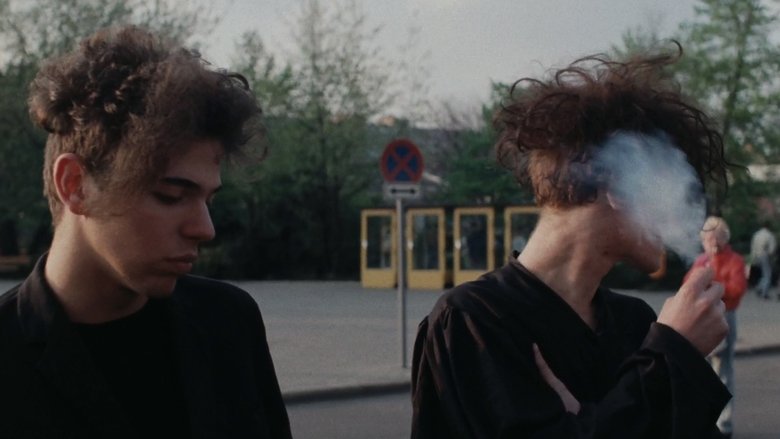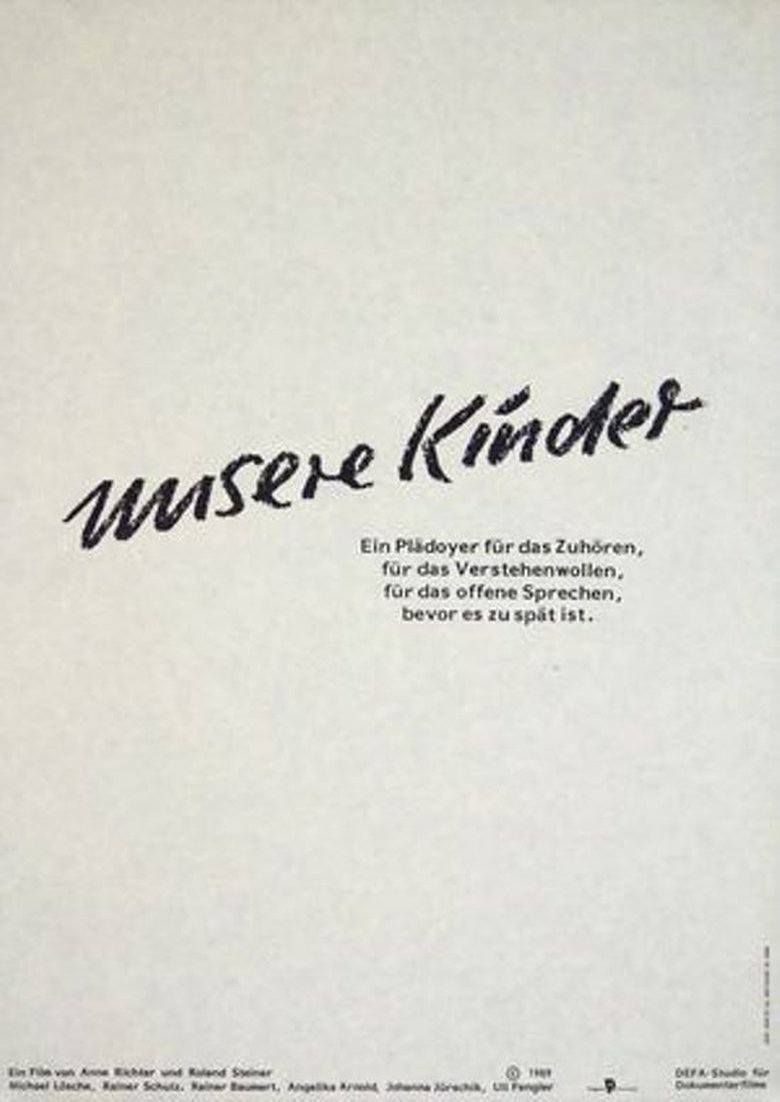

Our Children
Genres
Overview
From an official perspective, marginal youth culture did not exist in East Germany. The topic of subcultures was taboo in the GDR, and groups such as goths, skinheads, anti-skins, punks and neo-Nazis were dismissed as social deviations promoted by western countries. Director Roland Steiner had access to such young East Germans in the late 1980s. Over the course of four years, he brought them before the camera in an attempt to understand what drew them to these groups.
Details
Budget
$0
Revenue
$0
Runtime
88 min
Release Date
1989-11-30
Status
Released
Original Language
German
Vote Count
1
Vote Average
10
Roland Steiner
Self
Christa Wolf
Self
Stefan Heym
Self
10.0
Unarmed Verses
Toronto filmmaker Charles Officer profiles the young people of Villaways Park, a housing project on brink of historic change.
2017-05-01 | en
7.8
Finding the Gold Within
Six young black men from Akron, Ohio, enter college, determined to redefine society's images and low expectations. Despite their confidence, the stark reality of being away from home brings a series of crises. Well trained in critical and metaphorical thinking, and unusually articulate about their inner lives, each of the protagonists guides us to his core. Since sixth grade, they have been part of an innovative mentoring program called 'Alchemy, Inc.' that uses mythological stories, drumming and writing. In the twice-yearly reunion workshops everyone speaks of his trials and his triumphs with authenticity, intelligence, honesty and heart. In turns quiet, thoughtful and exuberant, the six protagonists grow before our eyes, whether navigating racial provocations, or seeking support with new friends, estranged fathers and wise grandmothers.
2014-10-03 | en
7.3
The Red Elvis
A documentary on the late American entertainer Dean Reed, who became a huge star in East Germany after settling there in 1973.
2007-02-13 | de
4.3
I Am My Own Woman
The life story of Charlotte von Mahlsdorf, who survived the Nazi reign as a trans woman and helped start the German gay liberation movement. Documentary with some dramatized scenes. Two actors play the young and middle aged Charlotte and she plays herself in the later years.
1992-10-30 | de
6.1
Prinzessinnenbad
A film about three teenagers - Klara, Mina and Tanutscha - from the Berlin district of Kreuzberg. The trio have known each other since Kindergarten and have plenty in common. The three 15-year-olds are the best of friends; they are spending the summer at Prinzenbad, a large open-air swimming pool at the heart of the district where they live. They're feeling pretty grown up, and are convinced they've now left their childhood behind.
2007-05-31 | de
5.3
Like It Is
This documentary on the "youth movement" of the late 1960s focuses on the hippie pot smoking/free love culture in the San Francisco Bay area.
1968-07-20 | en
6.6
Heimatkunde
Former "Titanic" satire magazine editor Martin Sonneborn takes an undercover trip around Berlin and discovers the East-German mentality and what is left of the socialist German Democratic Republic.
2008-10-01 | de
0.0
De Wereld aan je Voeten
In 2010, director Michiel van Erp started filming a group of children in Utrecht. He kept filming them till 2018, the year they turned 18. The film portrays those moments which were crucial for the development and personal growth of the kids.
2019-10-08 | nl
6.5
Puberty: Sexual Education For Boys and Girls
This sex education movie explore themes of body development, sexual hygiene, masturbation, menstruation, puberty, sex and giving birth.
1991-01-01 | nl
7.0
Los posibles
Santiago Mitre co-directs his first movement following The Student together with choreographer Onofri Barbato. Although it would have been more accurate to say “his first film-story-adventure-movie-great movie following The Student”, the word movement fits perfectly in Los posibles, the most overwhelmingly kinetic work Argentine cinema has delivered in many, many years. The film deals with the adaptation of a dance show directed by Onofri together with a group of teenagers who came to Casa La Salle, a center of social integration located in González Catán, trying to find some refuge from hardship. Already entitled Los posibles, the piece opened in the La Plata Tacec and was later staged in the AB Hall of the San Martín Cultural Center. Now, it dazzles audiences out of a film screen, with extraordinary muscles and a huge heart: Los posibles is a rhapsody of roughen bodies and torn emotions. Precise and exciting, it’s our own delayed, necessary, and incandescent West Side Story.
2013-04-01 | es
8.0
Last to Know
In the documentary Last To Know political prisoners, sent to jail for openly opposing the East German regime that existed until the German reunification in 1990, talk about their times of trial and their lives today. Neither they, nor their families have come to terms with what happened.
2006-02-11 | de
0.0
The Inflated Jungle
A series of suicides among youths who had to travel far from home to go to school, shocked their indigenous community in the Colombian Amazon. They are different cultures in the frantic friction of our time, it is a generation of young people born from the meeting of both cultures who are hanging before the mirages of a foreign world.
2015-05-08 | es
6.0
DDR - die entsorgte Republik
2019-10-02 | de
9.0
Cradle to Grave
Through our subject Adam, we reveal the incredible changes and forces that take all humankind from Cradle to Grave.
2017-01-08 | en
7.3
The Fallen
The documentary was shot in the prison for juvenile delinquents in Hungary. It does not aim at judging whether the perpetrators were convicted rightly or not but, given the burden they carry, how they can reintegrate into society after they are released.
1985-04-17 | hu
8.0
Time Loops - A Conversation with Christa Wolf
Journalist Daniela Dahn interviews the East-German author Christa Wolf during the German reunification: reflections on history, changing politics, life and work.
1991-01-02 | de
6.5
This Ain't California
A retrospective look at the youth cultures born in the German Democratic Republic. A celebration of the lust for life, a contemporary trip into the world of skate, a tale on three heroes and their boards, from their childhood in the seventies, through their teenage rebellion in the eighties and the summer of 1989, when their life changed forever, to 2011.
2012-08-15 | de
10.0
Mustafa's Sweet Dreams
The small Turkish town of Gaziantep. 16-year-old Mustafa is one of many young boys who study the complex art of making baklava, the Turkish desert renowned across the world. Under the strict eye of the master Baklava makers, Mustafa’s life is one of hard work and dedication to his chosen craft. But Mustafa dreams of a life beyond the confines of the workshop. He still wants to be a baklava master: he just wants to do it on his terms. Soon, against the advice of his friends and family, Mustafa makes a move towards the big city. Will his dreams be realised or will they crumble before him? A film about the impetuousness of youth and the importance of reaching for the stars, Angelos Abazoglou’s innnovative documentary is a moving and joyful coming-of-age tale which will speak to anyone who has ever wanted to fullfill their dreams.
2012-02-14 | tr
8.0
Reunification in the Ice: The Story of the Last GDR Antarctic Explorers
In 1989, thirteen GDR scientists and technicians set off from East Berlin to the Georg Forster research station in the Antarctic. During their expedition the Berlin Wall fell on November 9th. Cut off from the images that go around the world, the men can only experience the historical events passively. When they returned in the spring of 1991, their homeland was a foreign country. The documentary reconstructs the thoughts and feelings of the East German researchers on the basis of eyewitness accounts, diary excerpts, letters, film material, grandiose landscape shots from the location of the action and unique photos to make the consequences of the events tens of thousands of kilometers away on the small GDR expedition in the middle of the eternal ice tangible.
2020-10-02 | de
7.4
Gaza
GAZA brings us into a unique place beyond the reach of television news reports to reveal a world rich with eloquent and resilient characters, offering us a cinematic and enriching portrait of a people attempting to lead meaningful lives against the rubble of perennial conflict. Throughout its entire history the Gaza Strip has been witness to conflict and upheaval. From ancient times this tiny coastal territory, located at a crossroads between continents, has been a pawn whose fate rested in the hands of powerful neighbours.
2019-01-29 | en